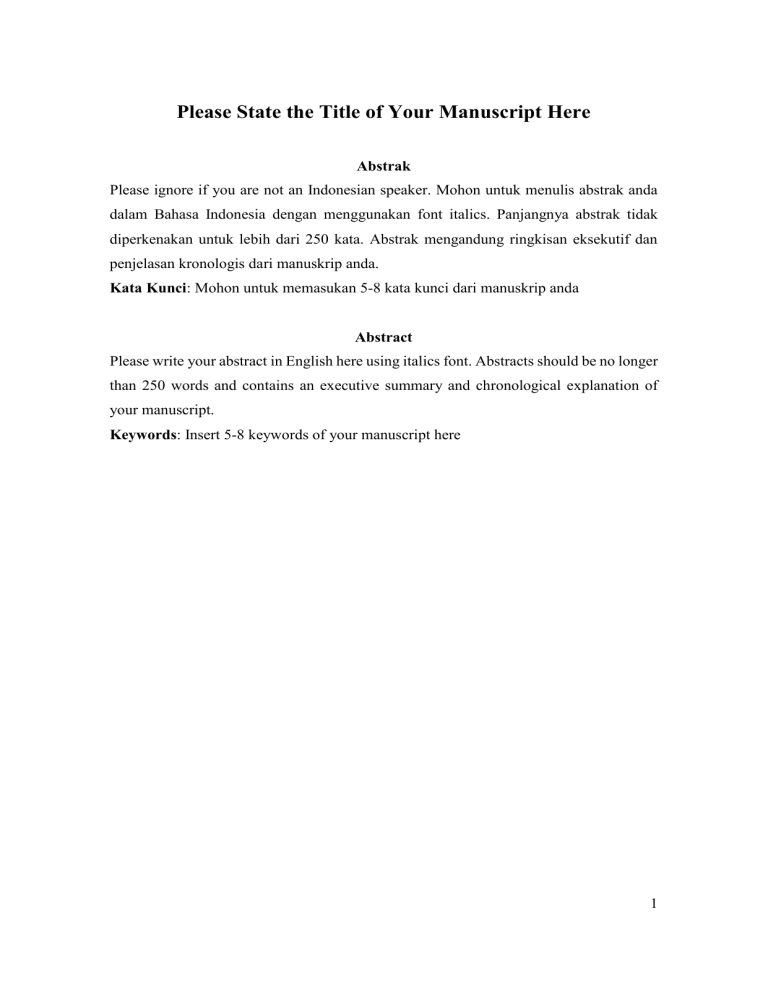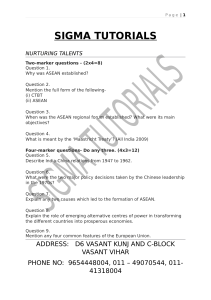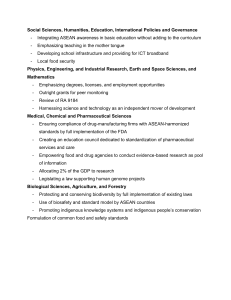
Please State the Title of Your Manuscript Here Abstrak Please ignore if you are not an Indonesian speaker. Mohon untuk menulis abstrak anda dalam Bahasa Indonesia dengan menggunakan font italics. Panjangnya abstrak tidak diperkenakan untuk lebih dari 250 kata. Abstrak mengandung ringkisan eksekutif dan penjelasan kronologis dari manuskrip anda. Kata Kunci: Mohon untuk memasukan 5-8 kata kunci dari manuskrip anda Abstract Please write your abstract in English here using italics font. Abstracts should be no longer than 250 words and contains an executive summary and chronological explanation of your manuscript. Keywords: Insert 5-8 keywords of your manuscript here 1 1. Introduction Please write your introduction here. You are advised to present the topic of your writing and the scope of your topic concisely. Furthermore, this section is an opportunity for the writer(s) to convince the reader that its chosen topic is indeed significant towards the discipline of International Relations. Include a description of how the manuscript is structured and what is to be expected at the end of the study. 2. Main Body, Divided into Sections and Subsections Following the introduction, arrange your main body into sections and subsections. Please keep to a maximum of 3 section tiers. An example is as follows: 2. Chinese Perception towards 2002 Declaration on Conduct of Parties in South China Sea 2.1. China’s Territorial Claim in South China Sea 2.2. Chinese Government views on ASEAN and the claimants to South China Sea 2.2.1. Chinese views on ASEAN during Deng Xiaoping 3. The Absence of ASEAN Centrality in achieving Code of Conduct in South China Sea 3.1. Continue your corresponding subsection here 3.2. And another subsection here if necessary Figures, charts, tables, and diagrams should be clearly captioned in order of appearance. Figures, charts, tables, and diagrams that exceed one page should be included in the appendix. Ensure figures, tables, and diagrams are at least 300dpi (or minimum 1,000 pixels in width) and be in either JPG or PNG format. Figures, tables, and diagrams will be published in color in the electronic version of the journal, and in black-and-white in the print version. Interview transcripts, photographic materials, documents, agreements, and other evidence used in the manuscript may be included in the appendices. You may subsequently refer to the appendix in your main body whenever applicable. 2 High internal threat High external threat Low external threat Poor Praetorian civil-military relations Low internal threat Strong civilian control Mixed Table 1 Threat theory of civilian control (Staniland, 2010) Figure 1 The maritime domain awareness-building loop (Agastia and Perwita, 2017) 3 3. Conclusion Please note that conclusion is not a summary. Conclusion is a synthesis of insights and findings that is used to further strengthen the validity of the manuscript. Please refrain from incorporating information and explanation that are not set forth in the introduction and main body. Note: The designated number for your conclusion should succeed the last number in your main body’s section. E.g. if the last section in your main body is number 4 then your designated conclusion number is 5. Acknowledgements Please write any acknowledgements, if any, in 200-300 words. This section does not count towards the total word count of the manuscript. If this research is sponsored by any research grants or funding from any institution, information regarding (a) the name of the grant/funding scheme and (b) the name of the institution providing the funding must be clearly indicated in this section. References Please list all the sources you have used in your in-text citations here. The references should be listed alphabetically using the American Psychological Association (APA) 6th edition style. Please see below examples of referencing common types of sources: Books One Author Acharya, A. (2014). The Making of Southeast Asia. Singapore: The Institute of Southeast Asian Studies. Two Authors Marsh, D. , & Stoker G. (2002). Theory and Methods in Political Science (2nd ed.). New York: Palgrave MacMillan More than Two Authors Przeworski, A., Stokes, S.C., & Manin, B. (1999). Democracy, Accountability, and Representation. Cambridge University Press. Edited Books 4 Murfett, M.H. (Ed). (2012). Cold War: Southeast Asia. Singapore: Marshall Cavendish Editions. Book Chapters Sukma, R. (2013). Major power relations, regional order, and Japan-ASEAN relations. In Er, L.P. (Eds.), Japan’s Relations with Southeast Asia: The Fukuda Doctrine and Beyond (pp. 52-62). London and New York: Routledge. Journal Articles Pugliese, G. (2016). Kantei Diplomacy? Japan’s hybrid leadership in foreign and security policy. The Pacific Review, 30 (2), 152-168. Webpages Amnesty International. (2018). USA: Policy of seperating children from parents is nothing short of torture. Retrieved from https://www.amnesty.org/en/latest/news/2018/06/usa-family-separation-torture/ Patel, C. (2017). Time for ASEAN to Take Human Rights Seriously. Retrived from https://thediplomat.com/2017/02/time-for-asean-to-take-human-rights-seriously/ Conference Proceedings (Unpublished) Moniaga, R. J. (2015, January). Indonesia’s Past, Present and Future Power, Image and Foreign Policy. Paper presented at the ISA Global South Caucus Conference, Singapore. Reports Australian Government Department of Foreign Affairs and Trade. (2017). Annual Report (Report Year 2016-2017). Canberra: Department of Foreign Affairs and Trade. Retrevied from: https://dfat.gov.au/about-us/publications/corporate/annual- reports/Documents/dfat-annual-report-2016-17.pdf Appendices Any evidence that are referred to in the manuscripts, e.g. figures, charts, tables, diagrams, interview transcripts, photographic materials, documents, agreements, and others can be included in the appendices. Please do not include any appendices that are not referred to in the manuscript. Allocate one page for each appendix and list them alphabetically by letters or chronologically by numbers, e.g. Appendix 1 or Appendix A, centered and written in bold letters. Examples are as follow: 5 Appendix A Source: Brennan, E. (2014). Religion in Southeast Asia: Diversity and the threat of extremes. Retrieved from: https://www.lowyinstitute.org/the-interpreter/religionsoutheast-asia-diversity-and-threat-extremes 6 Appendix B Five Principles of Japan's ASEAN Diplomacy Given changes to the strategic environment in the Asia-Pacific region and ASEAN's economic growth, ASEAN's presence and role in the region have been enhanced. It is therefore important that Japan further strengthen cooperation with ASEAN member states, not only on economic issues, but also other areas, such as security and political affairs. As part of this endeavor, Prime Minister Shinzo Abe visited Southeast Asia as his first trip abroad, which marks a kick-off the 40th Year of ASEAN-Japan Friendship and Cooperation. During his trip, Prime Minister Abe outlined the following "Five Principles" of Japan's ASEAN Diplomacy on January 18, 2013: 1. Protect and promote together with ASEAN member states universal values, such as freedom, democracy and basic human rights; 2. Ensure in cooperation with ASEAN member states that the free and open seas, which are the most vital common asset, are governed by laws and rules and not by force, and to welcome the United States' rebalancing to the Asia-Pacific region; 3. Further promote trade and investment, including flows of goods, money, people and services, through various economic partnership networks, for Japan's economic revitalization and prosperity of both Japan and ASEAN member states; 4. Protect and nurture Asia's diverse cultural heritages and traditions; 5. Promote exchanges among the young generations to further foster mutual understanding. Source: Ministry of Foreign Affairs of Japan. (2013). Factsheet on Japan-ASEAN Relations. Retrieved from http://www.mofa.go.jp/region/asia- paci/asean/factsheet.html 7



